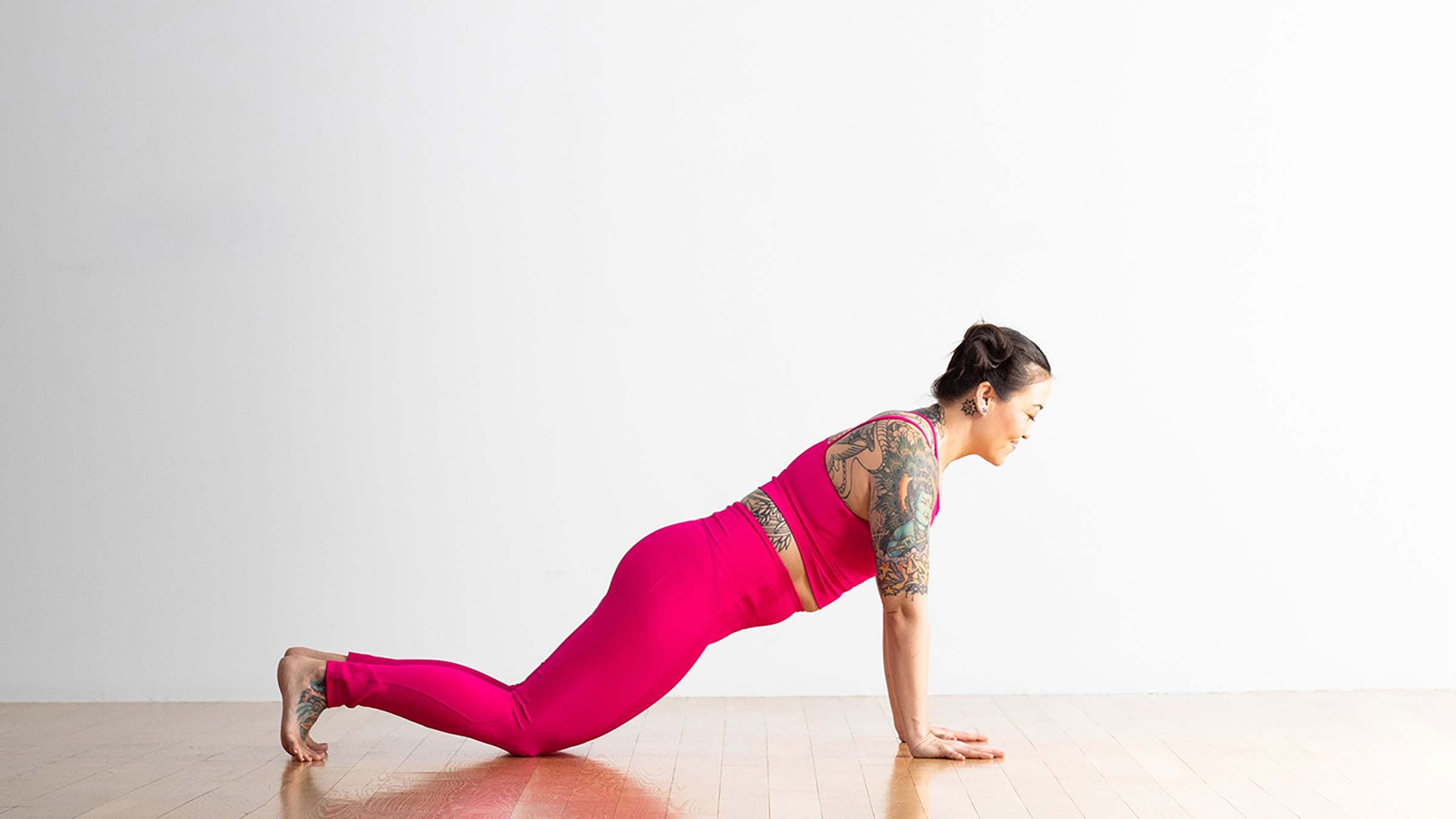What do rock climbers, swimmers, yoga practitioners, baseball players have in common? A tendency to overlook rotator cuff exercises that could help them stretch and strengthen the muscles that are prone to Add to that list anyone who has a desk-bound lifestyle, in which our shoulders can become tight and imbalanced from hours hunched over the keyboard, and anyone who spends a lot of time in everyday life experiencing repetitive overhead motion, such as painting a house.
This area of the body can easily become aggravated. Fortunately, it is possible to stretch and strengthen these muscles through rotator cuff exercises that can extend your range of motion, and reduce your chances of experiencing a debilitating injury.
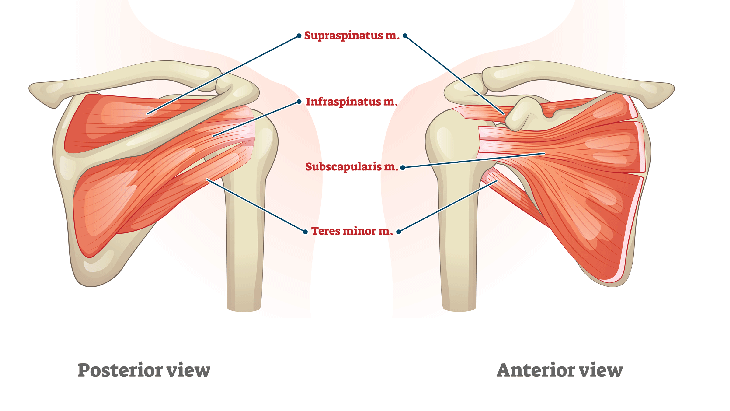
Rotator Cuff Anatomy
The rotator cuff comprises that stabilize the upper arm bone in the shoulder socket and allow the shoulder to rotate. The rotator cuff muscles include:
- Supraspinatus: helps you lift your arm
- Infraspinatus: externally rotates your arm
- Teres minor: stabilizes the glenohumeral joint
- Subscapularis: internally rotates your arm
These muscles coordinate with your wrists and arms to account for a significant portion of the movement that happens when you press up into a plank, lower your body weight to the floor, or stabilize your body throughout your workout. Abrupt movements, especially ones that require a considerable amount of force when pressing or pulling, can increase the challenges that these muscles face.
Each of these four muscles has a related tendon with an origin and an insertion point. The related tendons can also easily become irritated from repetitive motion, especially when there is weakness in the muscles that stabilize the shoulder blades and anchor the rotator cuffs.
What this means is a wide range of symptoms can be indicative of rotator cuff issues. Generally, pain is felt over the top of the shoulder, but it can extend to almost anywhere around the shoulder joint itself, including the shoulder blade and the armpit.
3 Rotator Cuff Exercises Inspired by Yoga
Practicing rotator cuff exercises that strengthen the muscles around the shoulder joint and restore your range of motion can create a stronger, more supportive structure. These exercises decrease your chance of experiencing a rotator cuff tear or facilitate your recovery from injury.
If you are experiencing pain, always consult with a physician prior to engaging in physical activity.
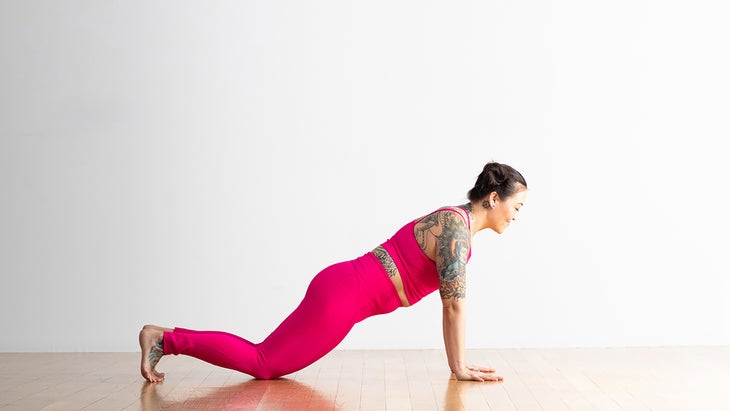
1. Plank Pose with knees down
How it strengthens the rotator cuff:�� strengthens the muscles around the shoulder blade—including the levator scapulae, rhomboids, and serratus anterior—to provide support for the rotator cuff. This motion is reminiscent of a scapular push-up.
How to practice: Either come to Plank Pose and lower your knees or come onto your hands and knees and slide your knees a few inches toward the wall behind you while keeping your toes tucked. As you exhale, without bending your elbows, slightly lower your rib cage toward the floor and draw your shoulder blades toward each other. As you inhale, push the floor away, pull your rib cage away from the floor, and, without rounding the spine, spread your shoulder blades apart. Visualize your shoulder blades gliding toward and away from each other around your rib cage.
You can keep your knees on the floor or come into Plank Pose and try the same movement there. Repeat 10 times, rest for a few breaths, and repeat. Work your way up to practicing 15 or 20 repetitions (eventually!).
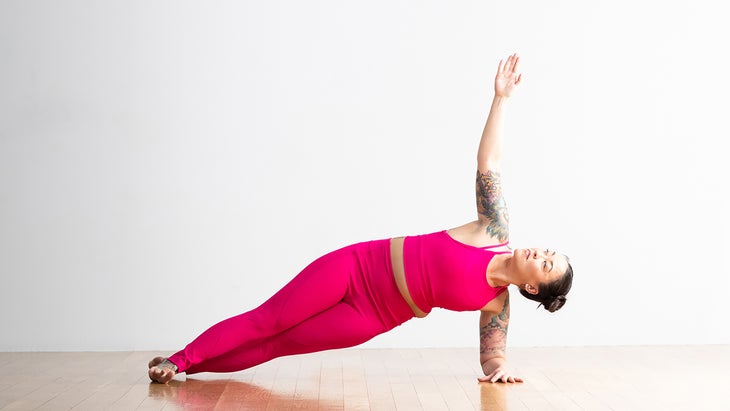
2. Side Plank Pose Variation
How it strengthens the rotator cuff: makes the muscles of the rotator cuff work as an integrated unit to keep your lowered arm and torso stable while they exert force.
How to practice: Come into Plank Pose and lower yourself onto your forearms with your elbows under your shoulders and your big toes touching. Roll onto the outer edge of your left foot and onto the inner edge of your right foot. Turn your left forearm in 45 to 90 degrees. Hug your left arm bone into the shoulder socket and press the base of your left index finger into the floor. Lift and lengthen through both sides of the rib cage and extend your right arm straight toward the ceiling. Breathe here for 30 to 60 seconds. Repeat on the other side.
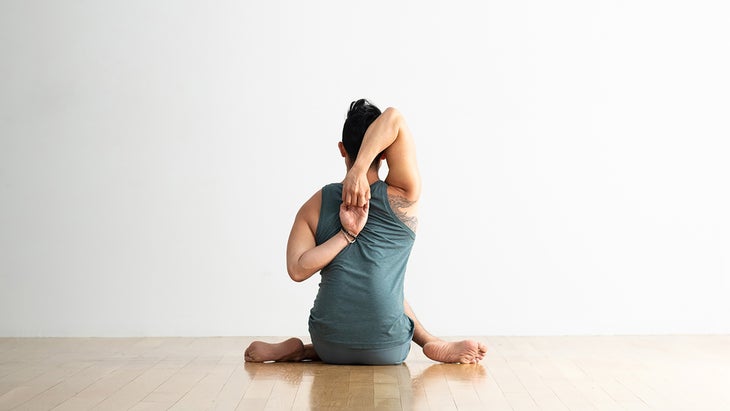
3. Cow Face Pose
How it supports the rotator cuff: This pose improves your range of motion by stretching the entire rotator cuff with a combination of internal and external rotation of the arms. If your shoulders are tight, you can do this pose in a warm shower. If you can’t touch your hands to each other, hold onto a strap or towel.
How to practice: From a seated or standing position, reach your left arm straight out to the left, parallel to the floor. Rotate your left arm inward so your thumb turns first toward the floor and then toward the wall behind you with your palm facing the ceiling. This movement will roll your left shoulder slightly up and forward and will round your upper back.
As you exhale, bend your left elbow and bring your left arm behind your torso. Draw your forearm toward your lower back with the left elbow against your back. Roll your shoulder back and down and then try to work your forearm up your back until its parallel to your spine and the back of your hand is between your shoulder blades.
Inhale and stretch your right arm straight ahead, parallel to the floor. Turn your palm up, inhale, and reach your arm straight�� toward the ceiling with your palm facing the wall behind you. Bend your elbow and reach for your left hand. If you can, clasp your hands in . If you can’t reach, take a towel, strap, or belt in your overhead hand and reach for it with your lower hand. Breathe here for 30 seconds. Repeat on the other side.
See also:


